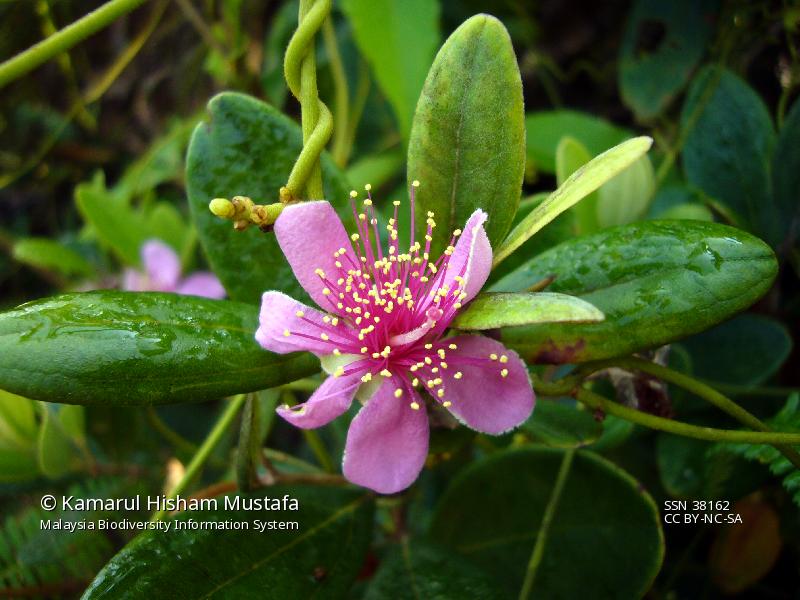
Rhodomyrtus tomentosa is an attractive member of the Myrtaceae family. The genus name Rhodomyrtus is derived from the Greek “rhodon” meaning red, and “myrtos”, meaning myrtle, referring to the rose-coloured flowers that are common in members of this genus. The species name tomentosa refers to the short, soft, matted hairs covering the undersides of the leaves and sepals of this species. The plant is popularly known as downy rose myrtle (English name) and locally as kemunting in Peninsular Malaysia, karamunting in Sabah or lidah katak in Sarawak. This species is native to tropical and subtropical Asia, from India, to southern China, Taiwan, Philippines, Malaysia and Sulawesi. It is often found in open sandy ground, on the seashore or banks of sandy rivers.
Rhodomyrtus tomentosa is a small shrub that can reach about 4 m tall. This species can be identified by the following features: young plant parts are woolly pubescent; the leaves are elliptic with rounded or blunt apex, hairy on the lower surface, up to 7 cm long and 4 cm wide, the petioles up to 0.5 cm long, and the flower petals pink or purplish in colour. The fruits are berries, green when young and turning to dark purple when mature, fleshy, sweet and aromatic. This species has many (40–45) tiny, deltoid seeds embedded in an edible flesh, and the seeds are dispersed by frugivorous birds and mammals.
Kemunting is occasionally cultivated for its edible fruits and medicinal uses. The sweet and aromatic ripe fruits are consumed fresh or made into pies, tarts, jellies, preserves and jams (Lim, 2012). Besides that, almost all parts of this species can be used for traditional medicinal purposes. For example, in Peninsular Malaysia, the fruits have been recorded as treatment for diarrhoea while the roots can be used for stomach ache and diarrhoea, and as a poultice at childbirth. An infusion of the roots is also recommended for squirting into the eyes to treat scars on the cornea. Root decoctions are drunk as a tonic in Sabah and Sarawak, and in Sarawak, leaves pounded together with betel leaves (Piper betle) and betel nut (Areca catechu) have been used as an abdominal poultice to mitigate diarrhoea in babies (Chai, 2006; Lim, 2012). In addition, its red wood is fine-grained and used for making small objects and the wood together with coconut shell is used for making wood tar for blackening the teeth and eyebrows (Lim, 2012).
Kemunting is also popular as an ornamental plant in gardens in the tropics and subtropics for its abundant and much prized flowers. The plant is easy to grow, with no serious pests and diseases reported so far, and is normally propagated using stem cuttings, bearing fruits within two years (Latiff, 1991).
